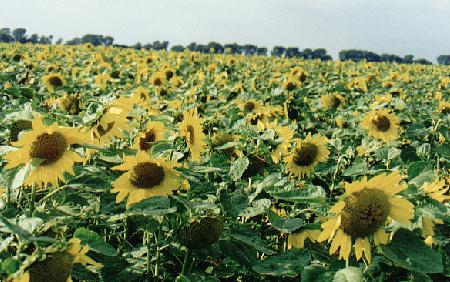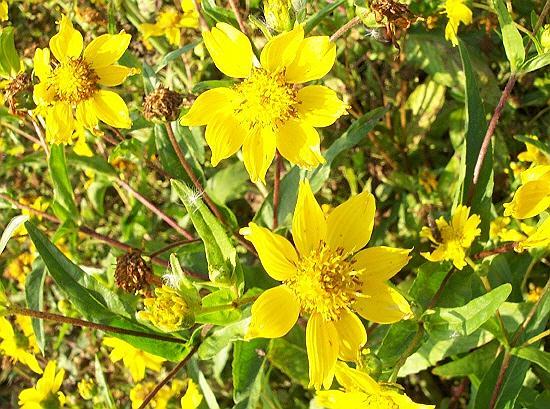|
Sunflowers
and nyger

Sunflowers being grown
over 60 acres of land at Baston Fen near Bourne by local
farmer Nicholas Watts who sells the seed for use on back garden bird
tables.
A colourful crop is creeping into the South Lincolnshire countryside where cereal production dominates the landscape. Side by side with the wheat and the barley in these wide open fields can now been seen the occasional burst of sunflowers that are being grown for their seeds and for the oil they produce.
The common sunflower (Helianthus annuus) is a native of Mexico and Peru and was introduced into this country in the 16th century but is now one of our most familiar garden plants. It has been grown commercially for many years but its appearance in this part of the country is relatively new and a field in full flower as you pass through the fens is a sight to behold.
The sunflower is an annual herb with a rough, hairy stem and grows three to twelve feet high. The genus Helianthus to which it belongs, contains about fifty species, chiefly natives of North America, the name being derived from helios, the sun and anthos, a flower, and is popularly supposed to have been given this name because of the belief that they follow the sun by day, always turning towards its direct rays, although the word sunflower is known in English literature long before the introduction of this Latin name and a better explanation is that it was so named because the flower resembles the radiant beams of the sun.
In Peru, the sunflower was much revered by the Aztecs 600 years ago and in their temples of the sun, the priestesses were crowned with sunflowers and carried them in their hands. The early Spanish conquistadors found numerous representations of the sunflower in these temples wrought in pure gold.
The sunflower also has a long history of medicinal applications. The leaves of the plant are used in herbal tobaccos and the seeds have diuretic and expectorant properties and have been employed with success in the treatment of bronchial conditions, coughs and colds while a tincture developed in the Caucasus region of Russia has been used in the treatment of malarial fever. In Turkey and Persia, a concoction prepared from the seeds with a mixture of wine has succeeded in the treatment of some fevers when quinine has failed.
Today, the sunflower is a ubiquitous garden plant and very popular with children because the seeds are large and easy to handle and require minimal attention while the end product is not only eye appealing but often a cause of competition with friends because they can grow over 20 feet tall and their bloom up to two feet in diameter. In the peak growing period, sunflowers can grow as much as 12 inches per day. The world record for the tallest sunflower is 25 feet 5½ inches that was grown in the Netherlands while the largest diameter head measured 32¼ inches and was reared at Maple Ridge in British Columbia, Canada. Growing sunflowers is therefore fun for the whole family who will be rewarded with not only a beautiful flower but also seeds for their pets and the birds.
The sunflower also has its place in art, the most famous exponent being the Dutch post-impressionist painter Vincent van Gogh who depicted them in a series of twelve pictures, all completed during the month of August, 1889, when they were in bloom and he worked fast because the flowers wilted so quickly once they had been cut. His most famous example,
Vase with Fourteen Sunflowers, was sold at auction in 1987 to a Japanese buyer for £22 million and can now been seen in the Seiji Togo Yasuda Memorial Museum of Modern Art in Tokyo.
But the sunflower is valuable from an economic as well as an ornamental point of view because every part of the plant can be utilised for some purpose. The leaves can be used to produce a cattle food and the stems contain a fibre for paper making. The seeds are rich in oil and reckoned to be the nearest approach to olive oil than any other known vegetable oil while the seeds can also be used to feed poultry and the flowers contain a yellow dye.
This then is an all round crop and one that is extremely popular in countries such as Russia and Spain, India and Japan. Sunflowers have also been grown in England for many years and even during the Second World War, the Ministry of Food issued information to growers about their cultivation and harvesting and undertook to purchase the ripened seed that was used in the manufacture of margarine and other essential fats used in the making of munitions. But sunflower production has been largely confined to the southern and south western counties where conditions are more tolerant and now the crop is beginning to appear over large tracts of the South Lincolnshire countryside and one farmer,
Nicholas Watts, a keen conservationist who has won many award, started growing them regularly on land at Baston Fen, near Bourne. With diversification high on the farming agenda, we can expect to see an even greater acreage of sunflowers in the future.

Nyger growing over three acres in a field at Baston Fen near Bourne
by local farmer and
conservationist Nicholas Watts.
In
2004, Mr Watts started experimenting with another delicacy favoured by our wild
birds and so another unusual crop began to appear in the fens around Bourne.
Nyger is a black seed that comes from an attractive yellow flower, a member of
the aster family and resembling a small sunflower. It is usually grown in Asia
and Africa for cooking oil but now also exported to Europe and the United States
as birdseed. It is extremely fine and very rich in oil and is similar to the
thistle or teasel and has become a favourite with finches and siskins that can
be fed all year round. But it does need special tube feeders with very small
slit openings although fine mesh bags also work well.
Mr Watts, who also sells a variety of birdseed from Vine House Farm at Deeping
St James, near Bourne, began growing nyger as part of his diversification
programme and three acres were devoted to the crop in 2004, probably the first
in Britain, and which was soon buzzing with hoverflies and bees that produce a
lot of honey from their visits. “It is an experiment but one that looks as
though it is going to work”, he said, “and we will definitely be growing more
next year if it is successful. The intensification of agriculture in Britain has
deprived birds of food and nesting sites. This has resulted in an alarming
decline in those species that rely on farmland.”
His own work in pursuit of conservation at Vine House Farm has produced
populations of reed bunting, yellowhammer, lapwing, barn owl, skylark and corn
bunting which are all expanding while the national average of these species
drops alarmingly.
REVISED AUGUST 2004

Go to:
Main Index Villages
Index
|

